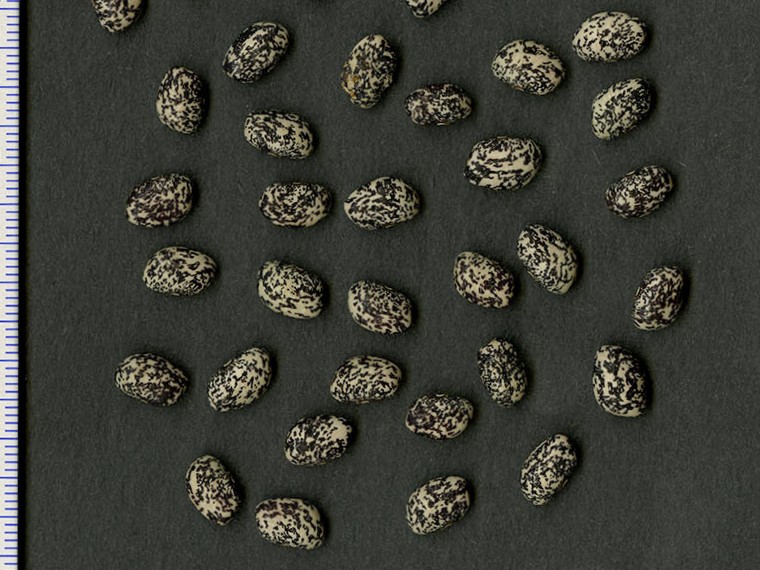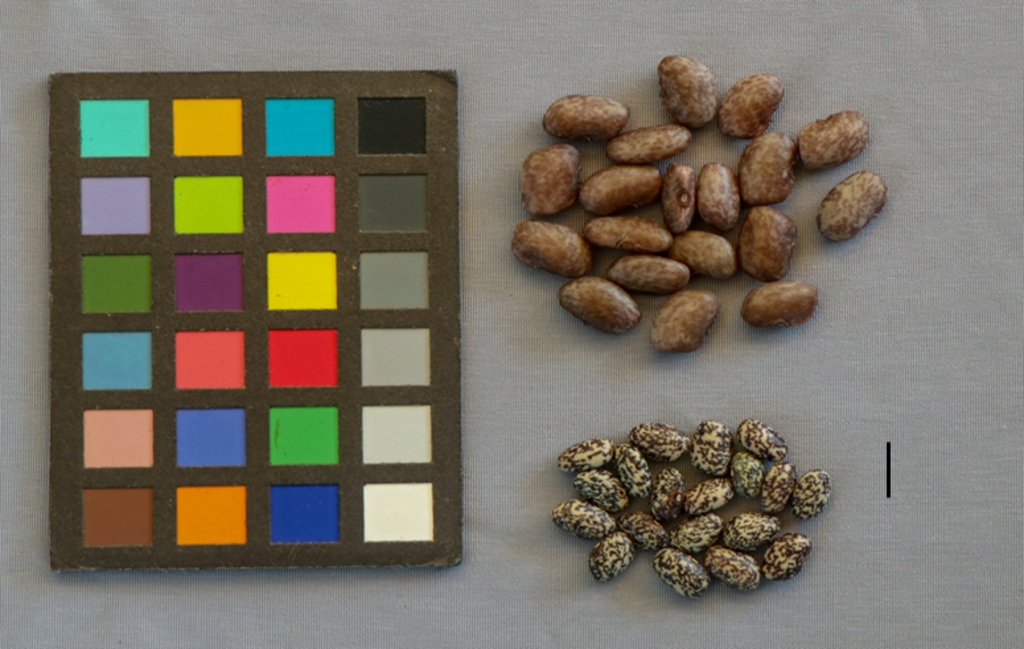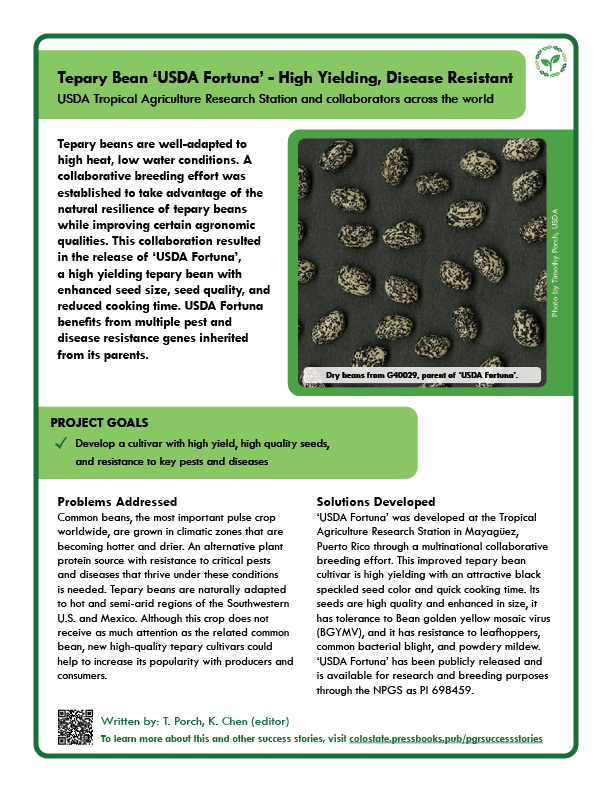Vegetables and Pulses
Tepary Bean ‘USDA Fortuna’ – High Yielding, Disease Resistant
A NEW TEPARY BEAN CULTIVAR WAS DEVELOPED WITH MULTIPLE DISEASE RESISTANCE, HIGH YIELD, AND FAST COOKING TIME
Timothy Porch
USDA-ARS Tropical Agriculture Research Station, 2200 P.A. Campos Ave, Suite 201, Mayagüez, Puerto Rico 00680.
Corresponding author: timothy.porch@usda.gov
OUTLINE
1. SUMMARY

Tepary beans are well-adapted to high heat, low water conditions. A collaborative breeding effort was established to take advantage of the natural resilience of tepary beans while improving certain agronomic qualities. The result was ‘USDA Fortuna’, a newly released tepary bean derived from National Plant Germplasm System (NPGS) landrace varieties from the deserts of the U.S. Southwest. USDA Fortuna is high yielding with enhanced seed size, seed quality, and reduced cooking time. It has shown tolerance to Bean golden yellow mosaic virus (BGYMV), resistance to leafhoppers, common bacterial blight, and some local strains of rust, and moderate resistance to powdery mildew.
The goal was to develop a high-yielding tepary bean cultivar with superior agronomic characteristics that can be grown in hot conditions and has resistance to key pests and diseases.
Download a printable fact sheet by clicking the image below.
2. PROBLEMS ADDRESSED
Common beans (Phaseolus vulgaris L.), the most important pulse crop worldwide, are grown in climatic zones that are becoming hotter and drier. An alternative plant protein source with resistance to critical pests and diseases that thrive under these conditions is needed. Tepary beans (Phaseolus acutifolius A. Gray) are naturally adapted to hot and semi-arid regions of the Southwestern U.S. and Mexico. Although this crop does not receive as much attention as the related common bean, new high-quality tepary cultivars could help to increase its popularity with producers and consumers.
3. SOLUTIONS DEVELOPED

USDA Fortuna was developed at the Tropical Agriculture Research Station (TARS) in Mayagüez, Puerto Rico through a multinational collaborative breeding effort. The original cross came from NPGS germplasm G40022 and G40029, two highly disease resistant accessions. This improved tepary bean cultivar is high yielding with an attractive black speckled seed color and quick cooking time. Its seeds are high quality and enhanced in size. It has tolerance to Bean golden yellow mosaic virus (BGYMV) in addition to leafhopper pest resistance, common bacterial blight resistance, moderate resistance to powdery mildew, and resistance to local strains of rust in Puerto Rico (Porch et al., 2024).
This new cultivar has been publicly released and is available for research and breeding purposes through the NPGS as PI 698459.
Collaborators involved in developing solution:
- Juan Carlos Rosas, Iveth Rodriguez Zamorano University, Tegucigalpa, Honduras
- Karen Cichy, USDA-ARS, Sugarbeet and Bean Research Unit, East Lansing, Michigan, USA
- Graciela Godoy Lutz, Instituto Dominicano de Investigaciones Agropecuarias y Forestales, Estacion Experimental de Arroyo Loro, San Juan de la Maguana, Republica Dominicana
- Raphael W. Colbert, Quisqueya University and Feed the Future Haiti-AREA, Port-au-Prince, Haiti
- Gasner Demosthene, Service National Semencier, Batiment Protection des Vegetaux, Ministere de L’Agriculture, Port-au-Prince, Haiti
- Juan Carlos Hernandez, Instituto Nacional de Innovacion y Transferencia en Tecnologia Agropecuraria (INTA), San Jose, Costa Rica
- Donna M. Winham, Department of Food Science and Human Nutrition, Iowa State University, Ames, Iowa, USA
- James S. Beaver, Agricultural Experiment Station, University of Puerto Rico, Mayaguez, Puerto Rico
4. GERMPLASM

G40022 (PI 321637) is a cultivated yellow tepary bean landrace with powdery mildew resistance, common bacterial blight resistance, heat tolerance, and small yellow round seeds, originating from the Tohono O’odham Nation in Arizona. G40029 (W6 38698) originally collected in the U.S. and donated to the NPGS from the International Center for Tropical Agriculture in Colombia, is a cultivated tepary bean landrace with high levels of common bacterial blight resistance and moderate tolerance to BGYMV with large black speckled seeds. USDA Fortuna (PI 698459) was selected under high temperatures in Juana Diaz, PR and tested in the Caribbean and Central America before release.
5. REFERENCES
Porch TG, Rosas JC, Cichy K, Lutz GG, Rodriguez I, Colbert RW, Demosthene G, Hernández JC, Winham DM, Beaver JS. 2024. Release of tepary bean cultivar ‘USDA Fortuna’ with improved disease and insect resistance, seed size, and culinary quality. Journal of Plant Registration 18:42-51. https://doi.org/10.1002/plr2.20322
6. CHAPTER INFORMATION
Citation: Porch T. 2024. Tepary Bean ‘USDA Fortuna’ – High Yielding, Disease Resistant. In: Volk GM, Chen K, Byrne P (Eds.) Plant Genetic Resources: Success Stories. Fort Collins, Colorado: Colorado State University. Date accessed. Available from https://colostate.pressbooks.pub/pgrsuccessstories/chapter/tepary-bean-usda-fortuna-high-yielding-disease-resistant/
Content originally submitted: March 17, 2024
Date of publication: August 13, 2024
USDA is an equal opportunity provider, employer, and lender. Mention of trade names or commercial products in this article is solely for the purpose of providing specific information and does not imply recommendation or endorsement by the U.S. Department of Agriculture.


